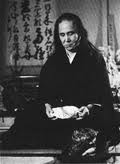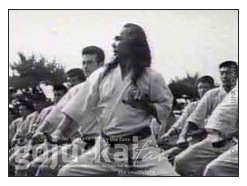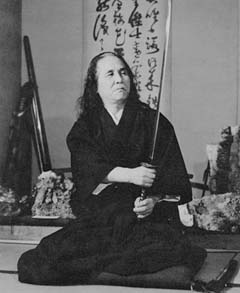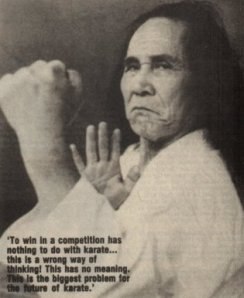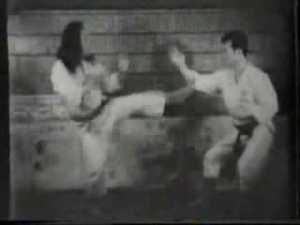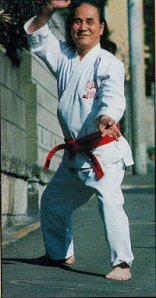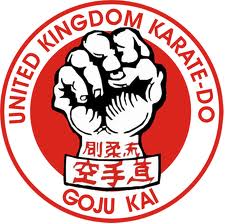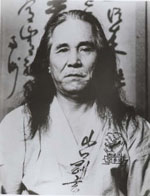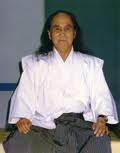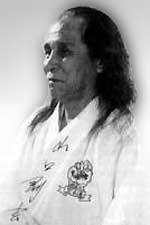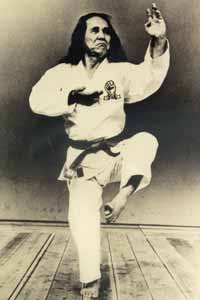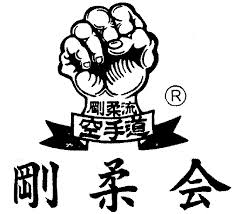Born: 20 January 1909
Died: 20 May 1989
Yamaguchi Gōgen was a world-renowned Grandmaster of Japanese Karate-dō and founder of the International Karate-dō Gōjū Kai Association. 1
Prior to his death, he was decorated by the Emperor of Japan in 1968 with the Ranjū-Hōshō, 2 the Blue Ribbon Medal of the fifth order of merit, for his enormous contribution to the world wide spread of Japanese martial arts.
For many years Gōgen Yamaguchi was listed in the Guinness Book of Records which regularly featured his rank and achievements.
His obituary included the following: His name was a household word in Karate circles and he appeared in all the major Martial Arts magazines and publications both in Japan and the western world. 3
Early years
According to his autobiographical work Karate Gojū-ryū by the Cat (Yamaguchi 1963), Gōgen Yamaguchi was born on January 20 in 1909 in Miyakonojōu Shonai, Miyazaki Prefecture, near Kagoshima City on the island of Kyūshū.
He was the third son of Tokutarō, a merchant and later a schoolteacher and superintendent, who named him Jitsumi Yamaguchi. His mother was Yoshimatsu. Jitsumi was their 3rd son, and there were ten children in this very large Japanese family.
In his 5th year of primary school (thirteen years of age) Yamaguchi commenced his karate-dō training under the instruction of Takeo Maruyama, a carpenter/joiner from Okinawa. Maruyama was a Gōjū-ryū Karate Kempo specialist.
He studied Law at Kansei University in 1928 and Ritsumeikan University from 1929 to 1937 and received Law Degrees. While studying at university he established the Karate club and invented its free sparring form. By this time, all karate schools in Okinawa and Japan practiced kata and pre-arranged application exercises but never attempted to practice free form of sparring.
In 1937, he received the name Gogen from Chojun Miyagi who authorized him to promote Gojū-ryū Karate in Japan.
In 1950, he founded the national organization of All Japan Karate-Do Goju-Kai in Tokyo, Japan and received his 10th Degree Black Belt from Chojun Miyagi Sensei in 1951.
As a result of the introduction of free-style sparring, the art of karate became a more active and popular art in Japan and other parts of the world. Although he studied such martial arts as Judo, Kendo, Iaido, Jo-do, and Kusari-gama (art of chain) as a young man, karate was, from the very beginning, where his true enthusiasm lay.
Gogen succeeded in bringing seventy Asian instructors to Japan and he travelled with them throughout the country holding exchange martial arts demonstrations. After the Pacific war he succeeded in unifying all the karate schools into one union, the All Japan Karate Federation, which was established in 1964.
The Cat
Gōgen Yamaguchi was famously known in the world of karate-dō as The Cat.
While he was small of stature – just over five feet (1.52 meters) and a mere 160 pounds (73 kg) – he gave the impression of great bulk and had an aura reminiscent of the samurai era.
He was first dubbed The Cat by American GI’s for his gliding walk and flowing hair.
According to Gōgen, w
When interviewed by French journalist Rolland Gaillac for the April 1977 edition of Karate magazine, Yamaguchi, at the age of 68, said: Even today, young man, if you were to face me in combat, I would be able to determine in a second the strength of your Ki. Immediately I would know if you were a good opponent. It is this quality, and no other, which has given me the name of The Cat.
Early Training
Gōgen began the serious study of karate-dō with Sensei Takeo Maruyama after his family relocated to Kyoto.
Gōgen Yamaguchi studied directly with Chojun Miyagi later in 1929 after he and his then-current teacher and friend Jitsuei Yogi wrote to Miyagi Sensei and invited him to come from Okinawa to Japan.
Gōgen meets Chōjun Miyagi
Chojun Miyagi visited the university dojo of Kansai, Osaka, Ritsumeikan, Kyoto and Doshisha Universities while Gōgen was attending Ritsumeikan University in Kyoto. There he studied Law and, in 1930, Jitsuei Yogi together with Gōgen Yamaguchi co-founded the Ritsumeikan daigaku karate kenkyū-kai (Ritsumeikan University Karate Research Association), the first karate club at Ritsumeikan University.
The Ritsumeikan Karate-dō Kenkyū-kai was the first university karate club in western Japan and was famous for its hard style training and fierce karate fighters. Both Yogi and Yamaguchi attended Ritsumeikan University during the time Chōjun Miyagi visited, and Chōjun Miyagi stayed in Yogi’s apartment.
Chōjun Miyagi later gave Gōgen Yamaguchi the responsibility for spreading Gōjū-ryū in mainland Japan.
In the early 1930s, Gōgen designed what would become the legendary signature Gōjū-ryū fist. It is, not surprisingly, said to be modelled after the right hand fist of Chōjun Miyagi.
The All Japan Karate-dō Gōjū-kai Federation
After graduating from Ritsumeikan University in Kyoto in 1934 Gōgen designed and introduced Jiyū-kumite which is known today as sport and tournament kumite.
In 1935 he officially formed the All Japan Karate-dō Gōjū-kai Karate-dō Association (which later split into the JKF Gojukai and the J.K.G.A.)
Also in 1935 Gōgen began his travels with the Japanese government as an intelligence officer and his first son Norimi Gōsei Yamaguchi was born.
Gōsei is the current leader of Gōjū-kai USA.
World War II
In 1942, during his World War II military tour in Manchuria, Gōgen was captured by the Soviet military and incarcerated as a prisoner of war in a Russian Concentration Camp. It was here that, according to his autobiography, he battled and defeated a live tiger. 4
Gōgen Yamaguchi was originally sentenced to hard labour in the POW camp however he impressed the Russians who discovered who he was and requested that he teach karate-dō to the Russian soldiers. It was then that, ‘the prisoner became the master of the guards, who, in turn, became his students’.
In 1945, Gōgen returned to Japan where he re-opened his initial karate-dō dojo in Nippori, which was later destroyed by fire, and advertised with a sign outside reading Gōjū-ryū-kai. Many people thought his school was closed forever and that he had been killed in the war so Gōgen held large exhibitions in Tokyo which showcased the various Chinese and Japanese martial arts that he had learned.
His school reopened and moved later to the Suginami-ku area of Tokyo. Here he quickly expanded throughout a network of independent Gōjū-ryū dojo. The rapid growth and expansion was reinforced by Gōgen’s energetic and forceful persona, which resulted in a worldwide network of karate schools, which he built into a powerful martial arts empire.
Opens Gōjū-ryū Honbu Dojo
Gōgen Yamaguchi established the Gōjū-kai Headquarters in Suginami-ku, Tokyo, Japan, nearby to the busy shopping precinct of Roppongi. It was also at this time that he registered the name Gōjū-ryū formally with the Butoku-kai, (the official government body and Headquarters for the Japanese Martial Arts).
By 1950, the Gōjū-kai Headquarters was officially relocated to the Suginami Tokyo school which contributed to an almost tripling of membership to 450,000, again according to his autobiography.
Five years later he officially chartered the I.K.G.A and in 1964 Yamaguchi, along with other founder members Ōtsuka Hironori from Wadō-ryū, Nakayama Masatoshi from Shotokan, Mabuni Kenei and Iwata Manzao of Shitō-ryū, unified all the karate dojo in Japan to form the All Japan Karate-dō Federation which is still in existence today but as the Japan Karate Federation (JKF).
Gōjū-ryū-kai Spreads Throughout the Western World
By 1966, his organization comprised more than 1,200 dojo and clubs and 600,000 members within the Gōjū-kai system. Peter Urban had opened his New York Dojo and initiated the spread of the style throughout the USA. In Australia, Paul Starling (the most senior Caucasian pupil graded by Gōgen Yamaguchi in his lifetime) had been training for four years with Gōgen’s first Australian student Mervyn Oakley.
Contributions to Budō
Gōgen Yamaguchi’s contributions to Gōjū-ryū karate-dō and to karate-dō in general have been enormous.
Under his leadership and guidance the International Karate-dō Gōjū-kai Association (I.K.G.A) has developed and thrived. The organization has increased in popularity both in Japan and other Asian and Western countries throughout the world.
By 2008 there were approximately 60-70 countries teaching the Gōjū-kai karate-dō principles and training methods.
Gōgen Yamaguchi succeeded in unifying all the karate schools in Japan into a single union which resulted in the formation of The Federation of All Japan Karate-dō Organization (F.A.J.K.O.) in 1964.
The Kokusai Budō Renmei – (The International Martial Arts Federation) in Japan, whose chairman was Prince Higashikuni of the Japanese Imperial Family appointed Master Yamaguchi as a Shihan – Master of that organisation’s karate-dō division.
Yamaguchi added to the Gōjū system the Taikyoku kata forms – training methods for the beginner students to prepare them for the more advanced kata.
It has been argued that ‘never before has a single man had such profound effect on the development and propagation of karate-dō’. 5 (De Jong,1989).
Gōgen Yamaguchi visited Sydney and Melbourne, Australia on two occasions, in 1970 and 1972.
The Yamaguchi Family
Gōgen Yamaguchi Kaiso died on the 20th of May 1989.
He had been married twice, firstly to Midori (who still lives on the island of Kyushu), with whom he had four children: Gōsei Norimi Yamaguchi (b. 1935), Gōsen Kishio Yamaguchi (1940-1990), Makiko Yamaguchi, and Gōshi Hirofumi Yamaguchi (b. 1942).
He and his second wife, Mitsue, had one child, Gōkyōko Wakako Yamaguchi.
All of his children practiced karate-dō and have become Masters in their own right.
The names commencing with gō were their karate names:
- Gōsei Norimi Yamaguchi has his own organisation in the United States
- Gōshi Hirofumi Yamaguchi is the President of the International Karate-dō Gōjū-kai, with branches in 60 countries
- Gōsen Kishio Yamaguchi was the Vice President of Japan Airlines
- Kishio, who died in the early 1990s, was deeply involved in the running of the I.K.G.A
- Wakako Yamaguchi, the youngest sister, was an All Japan Kata Champion for a number of years.
- Makiko Yamaguchi died from cancer at a relatively young age during the early 1980s.
References
1) interview with Shuji Tasaki
2) http://www.gojukai.com/photo.htm
3) Starling, Paul;The End of an Era, Obituary Gogen Yamaguchi in Australasian Fighting Arts, Aug/Sept Issue 1989 pp.68-70
4) Yamaguchi Gogen., Karate Gojū-ryū by the Cat., ibid
5) De Jong, Ingo, (1989). Goju-Kai Karate-do Hard and Soft in Harmony – Volume 1. Sweden, Jakobsbergs Tryckeri AB.
Sources
- Alexander, George, The Cat, Gogen Yamaguchi 10th Dan Collectors Edition DVD, (2002).
- Bishop, Mark, Okinawan Karate: Teachers, Styles and Secret Techniques, (1999).
- Black Belt Magazine, College of Hard Knocks, Gogen Yamaguchi’s Nippon Karate-dō Senmon Gakko. (Summer Edition 1974).
- Brennan, Kevin, Australasian Fighting Arts Magazine 1977 April Edition.
- Craig, DM, IAI: The Art Of Drawing The Sword
- De Jong, Ingo,Goju-Kai Karate-do Hard and Soft in Harmony Sweden, Jakobsbergs Tryckeri, (1989)
- Green, TA, Svinth JR, Modern Arts in the Modern World, (2003)
- Kanazawa, Hirokazu, Karate My Life, (2003).
- Kane et al., The Way of Kata: A Comprehensive Guide for Deciphering Martial Applications (2005)
- Kim, Richard, The Weaponless Warriors, (1974)
- Noble, Graham, The Life Story of Karate Master Gogen Yamaguchi, Dragon Times.
- Palabrica, Sonny (1966), The “Cat”. Gogen Yamaguchi, Head of Gojuryu Karate, Has Become A Legend in His Time, Black Belt Magazine, 28-35
- Ratti, O; Westbrook, A, Secrets of the Samurai: A Survey of the Martial Arts of Feudal Japan, (1999.)
- Starling, Paul, The End of an Era, Gogen Yamabuchi- Obituary, Australasian Fighting Arts,Aug-Sept Issue, p.p. 68-70 (1989). Training in Japan, Ibid, 1977 April issue.
- Urban, Peter, The Karate Dojo, (reprint 1991.)
- Urban, Peter, The Karate dojo, (1967)
- Williams, Johnpaul, All Gojuryu Network: Chronological Timeline (1999) http://www.gojuryu.net.
- Yamaguchi Gogen, Karate Gojū-ryū by the Cat. 1963 Rapid Print Co. Ltd Tokyo, Japan.
- Yamaguchi, Gogen, Goju-ryū Karate do Kyohan, Rising Sun Productions (1999)
- Yamaguchi, Goshi, Goju-ryū Karate A Visual Guide to Kumite Techniques Japan (1993)
- Yamaguchi, Norimi Gosei, Goju-ryū Karate do, Ohara Publications (1974)
- Headquarters of IKGA Japan
- Headquarters of IKGA Scandinavia and Europe
- Headquarters Sydney Australia
- Norimi Gosei Yamaguchi USA
- Article Graham Noble – Dragon Publications
- Shuji Tasaki Hanshi Interview – www.gojuryu.net

